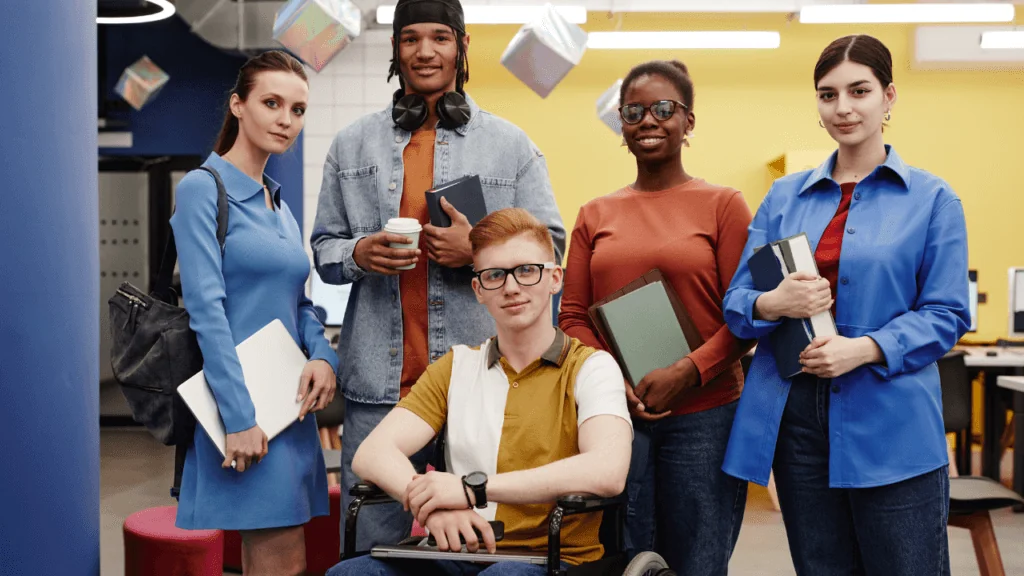Research shows that interactive learning, such as incorporating video, polls, and interactive presentations, is six times more effective in helping students learn.
This article aims to explore five of the most popular interactive learning trends you’ll see in 2024.
1. Mobile First Learning
Smartphones have become an important part of the lives of students and educators alike. A recent study showed that 97 percent of students ages 18 to 29 have a smartphone, and 95 percent of those students bring their phone to class.
“It is not surprising that 46 percent of students prefer completing coursework on their phone.”
It is not surprising that 46 percent of students prefer completing coursework on their phone, and 8 out of 10 students do. This access has driven the uptick in mobile-first learning, which allows teachers and students to use devices such as laptops, iPads, tablets, and smartphones to receive course content without the need for a traditional classroom.
The mobile-first learning environment can be supported with the use of technology such as the YuJa Enterprise Video Platform, YuJa Engage Student Response System, YuJa’s Mobile Apps for tablets and phones.
The Enterprise Video Platform allows institutions to have a video content management system that allows for the storage, management, distribution, and streaming of media content, which can be accessible remotely for educational settings taking place solely online.
The Engage Student Response System enables instructors to make the online learning experience more interactive by allowing students to collaborate and interact with the course content through Polls and Surveys, and providing immediate feedback.
YuJa also offers a mobile app for those who strictly uses a phone or tablet for learning, which offers HTML5 players and native apps for users to watch, record, upload and download content.
2. Gamified Learning
Gamified learning, or gamification, is another popular trend on the uptick in the world of higher education.
This approach integrates game elements into educational concepts, which increases the engagement and interaction from learners. This can be done through Polls and Surveys, which results in numerous benefits, including immediate feedback, an increase in critical thinking, and collaboration.
The YuJa Engage Student Response system is one way you can take part in this trend as it changes passive learning settings into an interactive experience by allowing instructors to gamify course content. This includes allowing instructors to create Polls with various question types such as short-answer, fill-in-the-blank, matching, true or false, and more. This platform also allows students to see clickable images for interactivity with visual materials.
3. Collaborative Learning
Collaboration is paramount in higher education today. Collaborative learning is similar to any collaborative session in that it has small groups of students work together to problem solve, innovate or complete a task. This in and of itself is not a new concept; however, in today’s digital age technology has given institutions the ability to do this online for students. YuJa offers LMS, third-party hardware and conferencing connectors for the video platform that allow instructors to streamline workflows and make course content more accessible to students.
Offering a collaborative learning environment in remote settings also gives students the ability to collaborate from multiple locations outside of the classroom and traditional hours.
4. Social Learning
Social learning is an environment in which students learn by observing or interacting with their peers. This is not a new concept in higher education, but how it applies to the use of technology in education is newer.
Educators are now tasked with creating an atmosphere that fosters connection, collaboration and engagement beyond the traditional walls of a classroom. This change in tactics can be seen through the increased use of flipped classrooms where learning takes on a more interactive role during physical classroom hours and course content is consumed prior to class.
This approach gives students more flexibility in consuming course content, empowers them to take ownership of their learning, and deepens their relationships in the classroom because it allows them to work more closely together. YuJa can help facilitate flipped classrooms, allowing both students and instructors to focus on the course content rather than technology.
5. Microlearning
While historically used in corporate training, microlearning has made its entrance into the world of higher education. Microlearning is typically used when lessons or concepts are taught in short, concise pieces of content.
By keeping content short, concise and chunked into smaller concepts allows for better retention. Microlearning is ideal because it offers more flexibility and control for students of what and when they learn — which can be especially beneficial for students who are attending classes online, those who are working, or who have other responsibilities that need tended to during regular school hours.
YuJa’s ed-tech tools can assist in not only the creation of micro lessons but also increase engagement video quizzes, analytics, and more.
Looking Ahead
Trends this year all support collaborative and interactive learning environments, regardless of location or device used. While the wheel of effective teaching in 2024 may be reinvented from years ago, the goal of education has remained the same — to give students the opportunity and support needed for educational success.









